RhB@MOF-5 Composite Film as a Fluorescence Sensor for Detection of Chilled Pork Freshness
Abstract
1. Introduction
2. Materials and Methods
2.1. Materials
2.2. Preparation of RhB@MOF-5 Composite Film
2.3. Instrumentation
2.4. Storage Stablity Experiment
2.5. Standard Measurement of Freshness Indicator
2.6. Statistical Analysis
3. Results and Discussion
3.1. Synthesis and Characterization of RhB@MOF-5
3.1.1. Selection of RhB Concentration
3.1.2. Characterization of RhB@MOF-5
3.2. Response of RhB@MOF-5 to Volatile Compounds during Pork Deterioration
3.2.1. Analysis of Characteristic Volatile Components by Electronic Nose
3.2.2. Infrared Analysis of RhB@MOF-5 Response to Pork Deterioration
3.2.3. Fluorescence Sensing Analysis of RhB@MOF-5 Response to Pork Deterioration
3.3. Application of RhB@MOF-5 Composite Film to Detecting Chilled Pork Freshness
4. Conclusions
Supplementary Materials
Author Contributions
Funding
Institutional Review Board Statement
Informed Consent Statement
Data Availability Statement
Conflicts of Interest
References
- Bruckner, S.; Albrecht, A.; Petersen, B.; Kreyenschmidt, J. Influence of Cold Chain Interruptions on the Shelf Life of Fresh Pork and Poultry: Influence of Cold Chain Interruptions. Int. J. Food Sci. Technol. 2012, 47, 1639–1646. [Google Scholar] [CrossRef]
- Li, N.; Zhang, Y.; Wu, Q.; Gu, Q.; Chen, M.; Zhang, Y.; Sun, X.; Zhang, J. High-Throughput Sequencing Analysis of Bacterial Community Composition and Quality Characteristics in Refrigerated Pork during Storage. Food Microbiol. 2019, 83, 86–94. [Google Scholar] [CrossRef] [PubMed]
- Tian, X.-Y.; Cai, Q.; Zhang, Y.-M. Rapid Classification of Hairtail Fish and Pork Freshness Using an Electronic Nose Based on the PCA Method. Sensors 2011, 12, 260–277. [Google Scholar] [CrossRef] [PubMed]
- Li, M.; Wang, H.; Sun, L.; Zhao, G.; Huang, X. Application of Electronic Nose for Measuring Total Volatile Basic Nitrogen and Total Viable Counts in Packaged Pork During Refrigerated Storage: E-Nose for Predicting TVB-N and TVC. J. Food Sci. 2016, 81, M906–M912. [Google Scholar] [CrossRef] [PubMed]
- Eglitis, R.I.; Purans, J.; Gabrusenoks, J.; Popov, A.I.; Jia, R. Comparative Ab Initio Calculations of ReO3, SrZrO3, BaZrO3, PbZrO3 and CaZrO3 (001) Surfaces. Crystals 2020, 10, 745. [Google Scholar] [CrossRef]
- Zhang, Y.J.; Chen, E.X. Comprehensive Monitoring System of Fresh Food Cold Chain Logistics. AMM 2014, 602–605, 2340–2343. [Google Scholar] [CrossRef]
- Ezati, P.; Bang, Y.-J.; Rhim, J.-W. Preparation of a Shikonin-Based PH-Sensitive Color Indicator for Monitoring the Freshness of Fish and Pork. Food Chem. 2021, 337, 127995. [Google Scholar] [CrossRef] [PubMed]
- Zhang, J.; Zou, X.; Zhai, X.; Huang, X.; Jiang, C.; Holmes, M. Preparation of an Intelligent PH Film Based on Biodegradable Polymers and Roselle Anthocyanins for Monitoring Pork Freshness. Food Chem. 2019, 272, 306–312. [Google Scholar] [CrossRef]
- Sun, W.; Li, H.; Wang, H.; Xiao, S.; Wang, J.; Feng, L. Sensitivity Enhancement of PH Indicator and Its Application in the Evaluation of Fish Freshness. Talanta 2015, 143, 127–131. [Google Scholar] [CrossRef]
- Kim, D.; Lee, S.; Lee, K.; Baek, S.; Seo, J. Development of a PH Indicator Composed of High Moisture-Absorbing Materials for Real-Time Monitoring of Chicken Breast Freshness. Food Sci. Biotechnol. 2017, 26, 37–42. [Google Scholar] [CrossRef]
- Liu, J.; Wang, H.; Wang, P.; Guo, M.; Jiang, S.; Li, X.; Jiang, S. Films Based on κ-Carrageenan Incorporated with Curcumin for Freshness Monitoring. Food Hydrocoll. 2018, 83, 134–142. [Google Scholar] [CrossRef]
- Tranchemontagne, D.J.; Mendoza-Cortés, J.L.; O’Keeffe, M.; Yaghi, O.M. Secondary Building Units, Nets and Bonding in the Chemistry of Metal–Organic Frameworks. Chem. Soc. Rev. 2009, 38, 1257. [Google Scholar] [CrossRef]
- Perry IV, J.J.; Perman, J.A.; Zaworotko, M.J. Design and Synthesis of Metal–Organic Frameworks Using Metal–Organic Polyhedra as Supermolecular Building Blocks. Chem. Soc. Rev. 2009, 38, 1400. [Google Scholar] [CrossRef] [PubMed]
- Ma, S. Gas Adsorption Applications of Porous Metal–Organic Frameworks. Pure Appl. Chem. 2009, 81, 2235–2251. [Google Scholar] [CrossRef]
- Uzun, A.; Keskin, S. Site Characteristics in Metal Organic Frameworks for Gas Adsorption. Prog. Surf. Sci. 2014, 891, 56–79. [Google Scholar] [CrossRef]
- Li, J.-R.; Kuppler, R.J.; Zhou, H.-C. Selective Gas Adsorption and Separation in Metal–Organic Frameworks. Chem. Soc. Rev. 2009, 38, 1477. [Google Scholar] [CrossRef]
- Montoro, C.; Linares, F.; Quartapelle Procopio, E.; Senkovska, I.; Kaskel, S.; Galli, S.; Masciocchi, N.; Barea, E.; Navarro, J.A.R. Capture of Nerve Agents and Mustard Gas Analogues by Hydrophobic Robust MOF-5 Type Metal–Organic Frameworks. J. Am. Chem. Soc. 2011, 133, 11888–11891. [Google Scholar] [CrossRef]
- Koh, C.S.L.; Lee, H.K.; Han, X.; Sim, H.Y.F.; Ling, X.Y. Plasmonic Nose: Integrating the MOF-Enabled Molecular Preconcentration Effect with a Plasmonic Array for Recognition of Molecular-Level Volatile Organic Compounds. Chem. Commun. 2018, 54, 2546–2549. [Google Scholar] [CrossRef]
- Lustig, W.P.; Mukherjee, S.; Rudd, N.D.; Desai, A.V.; Li, J.; Ghosh, S.K. Metal–Organic Frameworks: Functional Luminescent and Photonic Materials for Sensing Applications. Chem. Soc. Rev. 2017, 46, 3242–3285. [Google Scholar] [CrossRef]
- Raja Lakshmi, P.; Nanjan, P.; Kannan, S.; Shanmugaraju, S. Recent Advances in Luminescent Metal–Organic Frameworks (LMOFs) Based Fluorescent Sensors for Antibiotics. Coord. Chem. Rev. 2021, 435, 213793. [Google Scholar] [CrossRef]
- Yassine, O.; Shekhah, O.; Assen, A.H.; Belmabkhout, Y.; Salama, K.N.; Eddaoudi, M. H 2 S Sensors: Fumarate-Based Fcu-MOF Thin Film Grown on a Capacitive Interdigitated Electrode. Angew. Chem. Int. Ed. 2016, 55, 15879–15883. [Google Scholar] [CrossRef] [PubMed]
- Dong, M.-J.; Zhao, M.; Ou, S.; Zou, C.; Wu, C.-D. A Luminescent Dye@MOF Platform: Emission Fingerprint Relationships of Volatile Organic Molecules. Angew. Chem. Int. Ed. 2014, 53, 1575–1579. [Google Scholar] [CrossRef] [PubMed]
- Guo, L.; Liu, Y.; Kong, R.; Chen, G.; Wang, H.; Wang, X.; Xia, L.; Qu, F. Turn-on Fluorescence Detection of β-Glucuronidase Using RhB@MOF-5 as an Ultrasensitive Nanoprobe. Sens. Actuators B Chem. 2019, 295, 1–6. [Google Scholar] [CrossRef]
- GB/T 5009. 228-2016; China National Food Safety Standard: Method for Analysis of Hygienic Standard of Meat and Meat Products. National Health and Family Planning Commission of the People’s Republic of China: Beijing, China, 2016. [Google Scholar]
- Mantanus, J.; Ziémons, E.; Lebrun, P.; Rozet, E.; Klinkenberg, R.; Streel, B.; Evrard, B.; Hubert, Ph. Active Content Determination of Non-Coated Pharmaceutical Pellets by near Infrared Spectroscopy: Method Development, Validation and Reliability Evaluation. Talanta 2010, 80, 1750–1757. [Google Scholar] [CrossRef][Green Version]
- Liu, H.; Ji, Z.; Liu, X.; Shi, C.; Yang, X. Non-Destructive Determination of Chemical and Microbial Spoilage Indicators of Beef for Freshness Evaluation Using Front-Face Synchronous Fluorescence Spectroscopy. Food Chem. 2020, 321, 126628. [Google Scholar] [CrossRef]
- Lee, L.C.; Liong, C.-Y.; Jemain, A.A. Partial Least Squares-Discriminant Analysis (PLS-DA) for Classification of High-Dimensional (HD) Data: A Review of Contemporary Practice Strategies and Knowledge Gaps. Analyst 2018, 143, 3526–3539. [Google Scholar] [CrossRef]
- Liu, Y.; Ng, Z.; Khan, E.A.; Jeong, H.-K.; Ching, C.; Lai, Z. Synthesis of Continuous MOF-5 Membranes on Porous α-Alumina Substrates. Microporous Mesoporous Mater. 2009, 118, 296–301. [Google Scholar] [CrossRef]
- Chen, X.; Jia, J.; Ma, H.; Wang, S.; Wang, X. Characterization of Rhodamine B Hydroxylamide as a Highly Selective and Sensitive Fluorescence Probe for Copper(II). Anal. Chim. Acta 2009, 632, 9–14. [Google Scholar] [CrossRef]
- Albani, J.R. Principles and Applications of Fluorescence Spectroscopy, 1st ed.; Wiley: Hoboken, NJ, USA, 2007; ISBN 978-1-4051-3891-8. [Google Scholar]
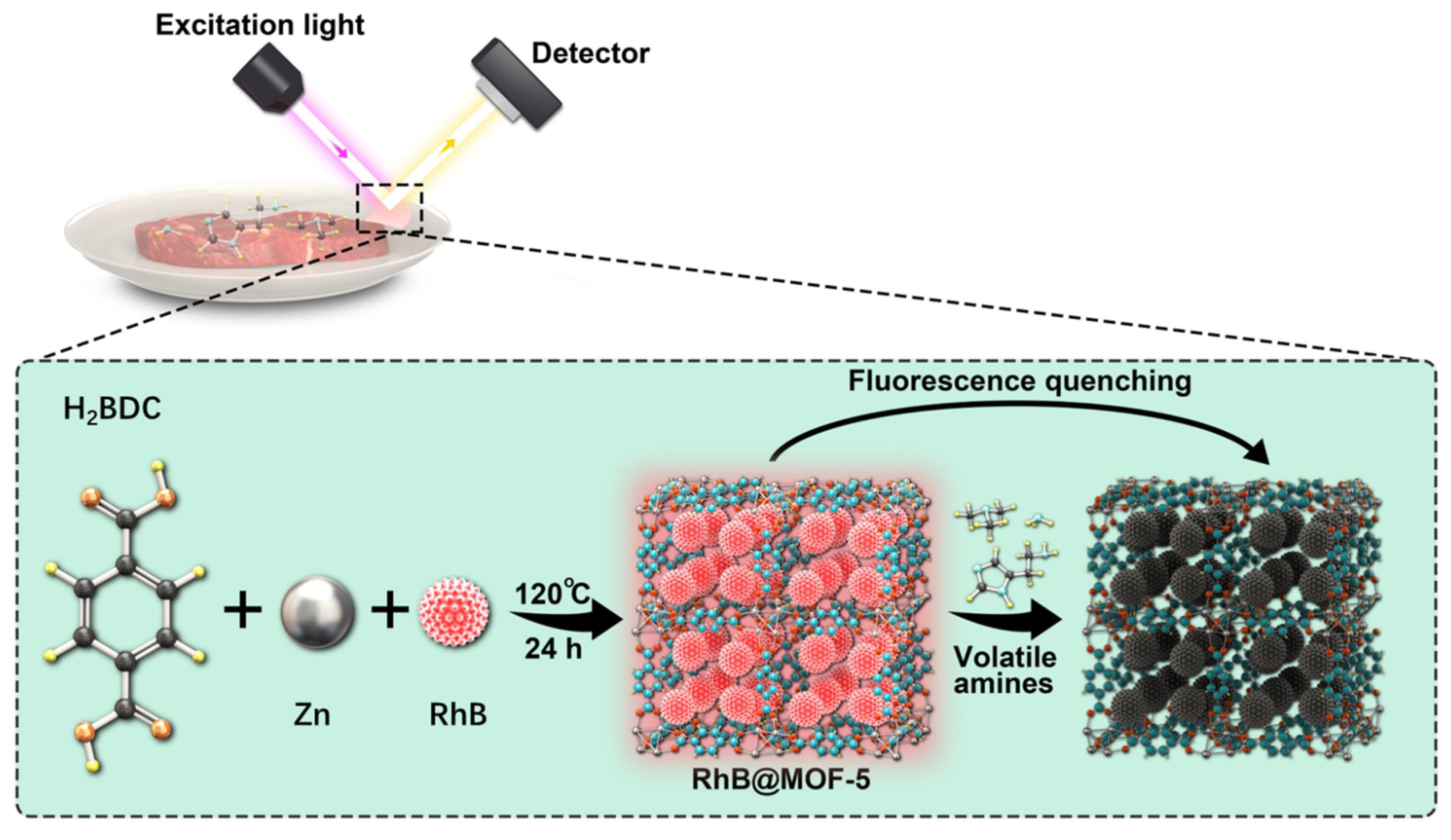
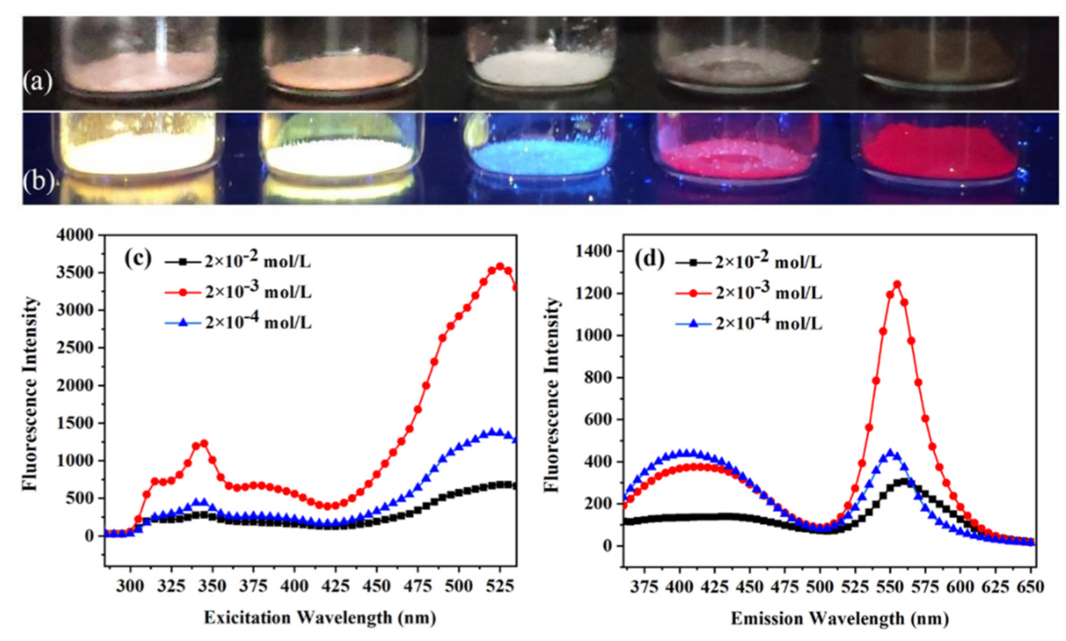
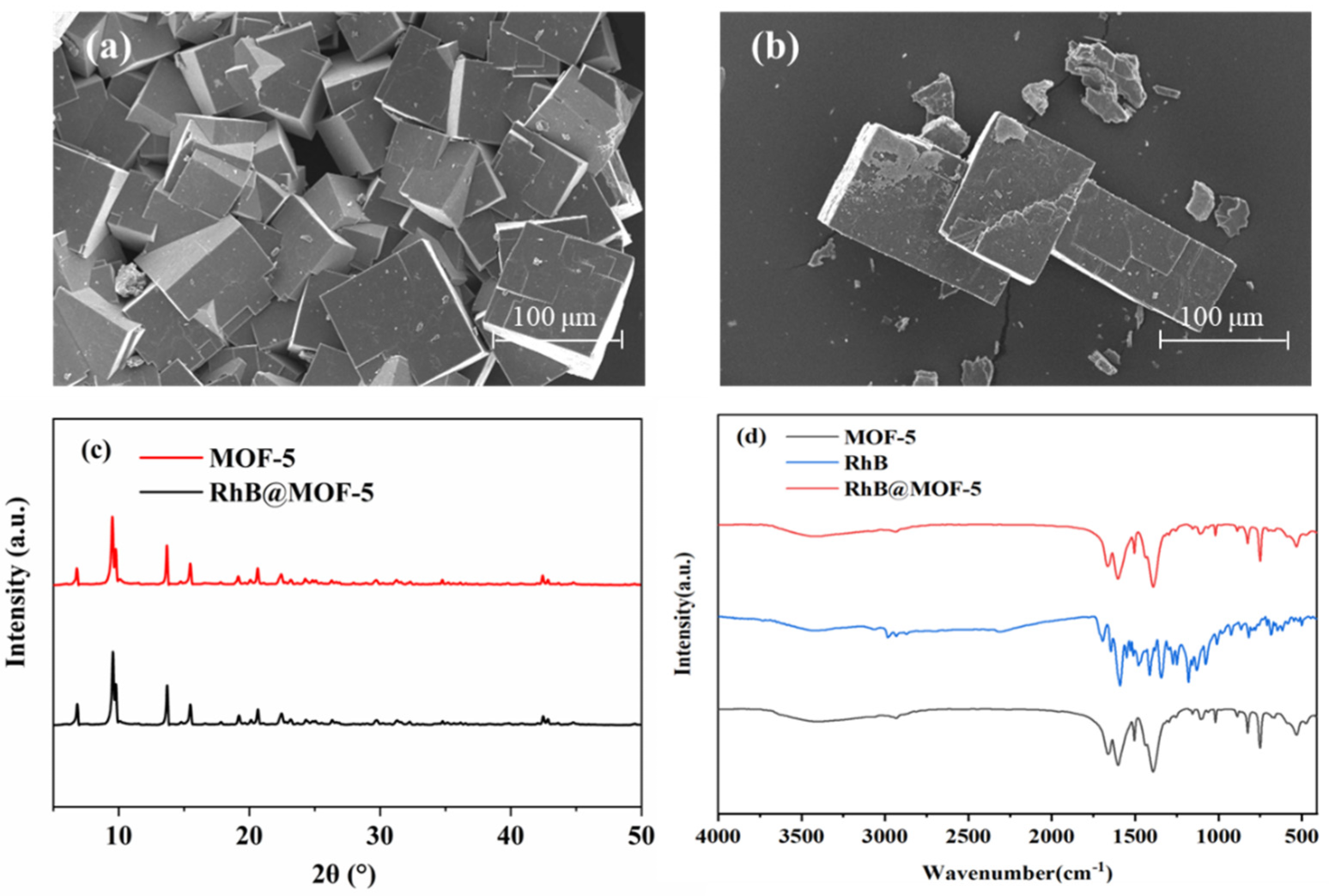
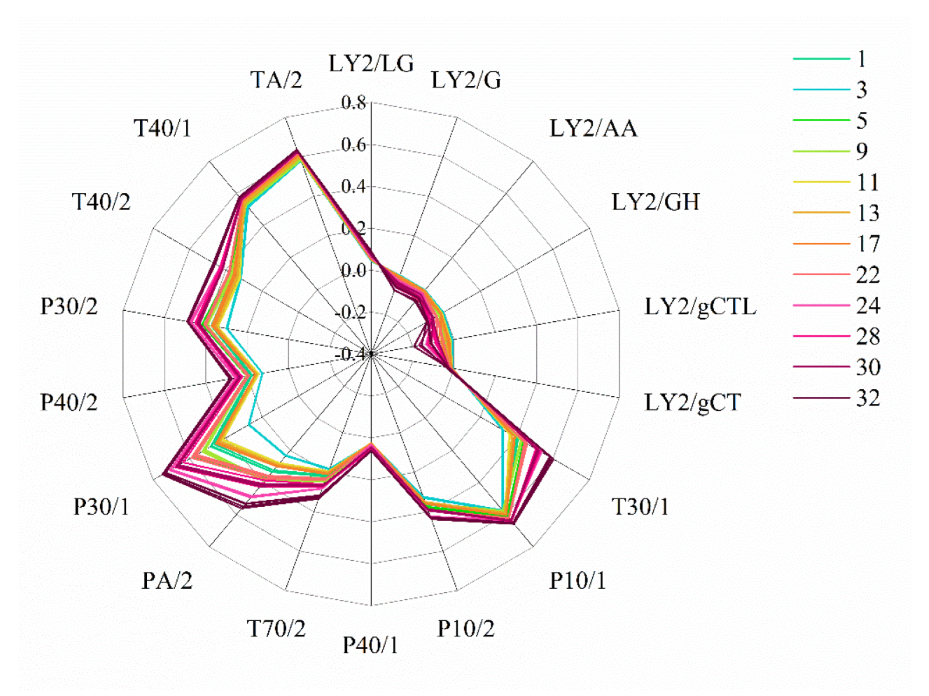
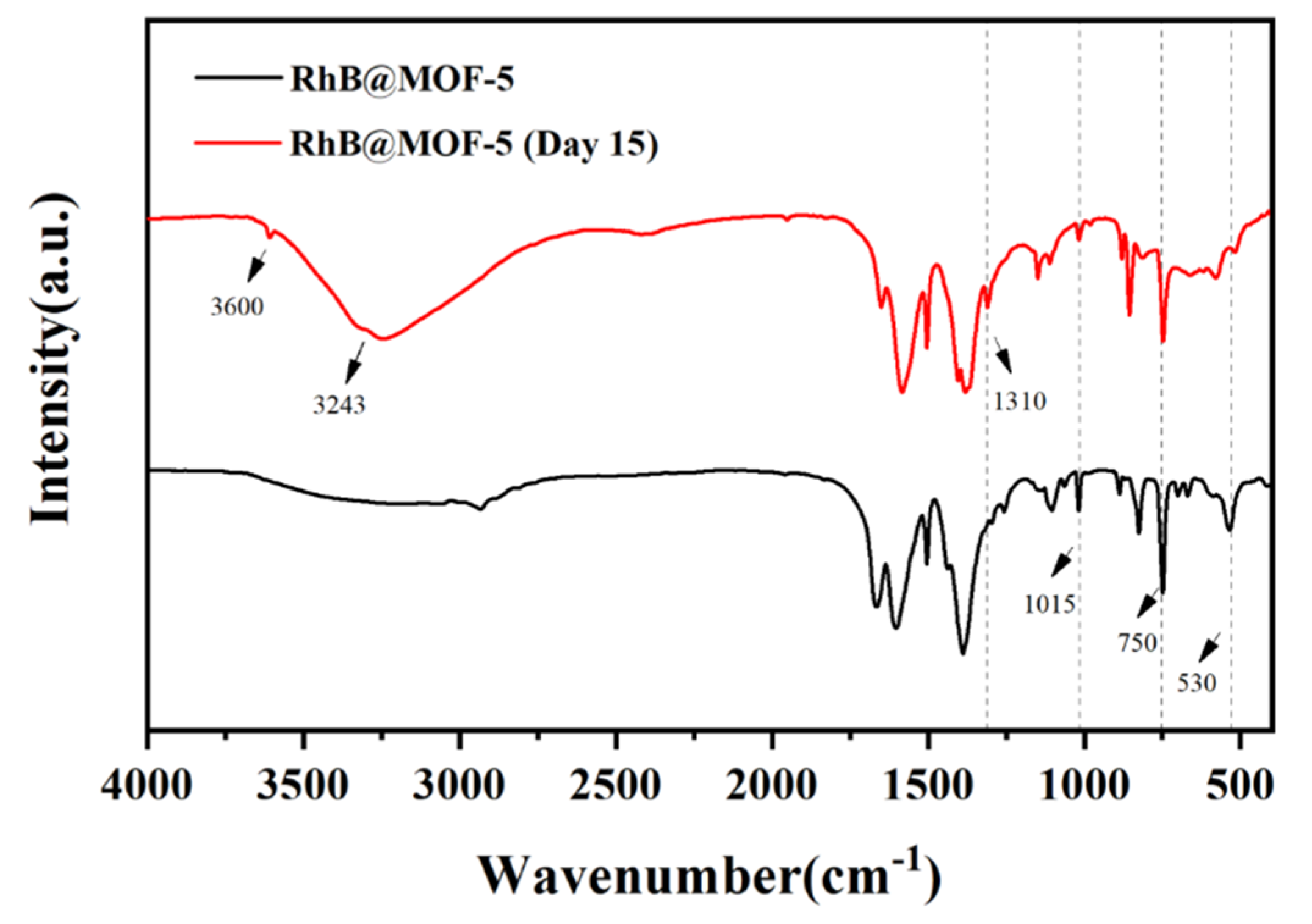
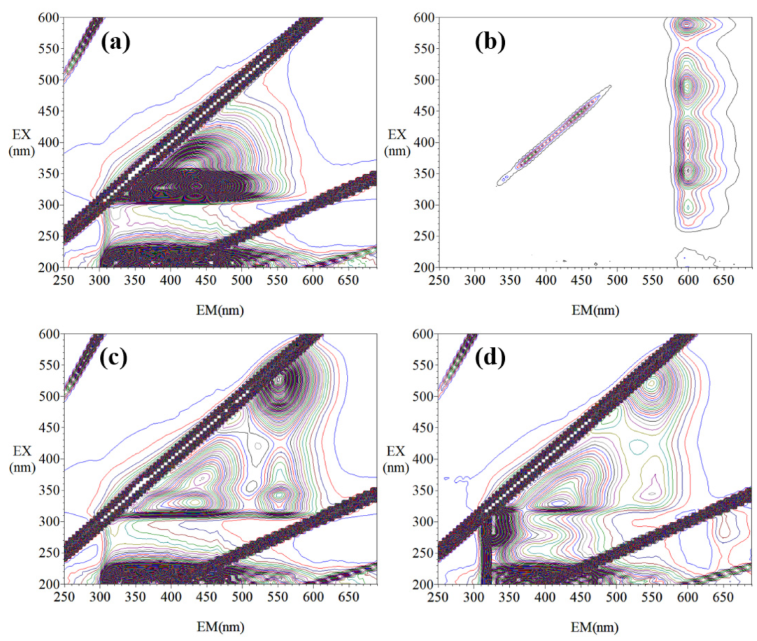
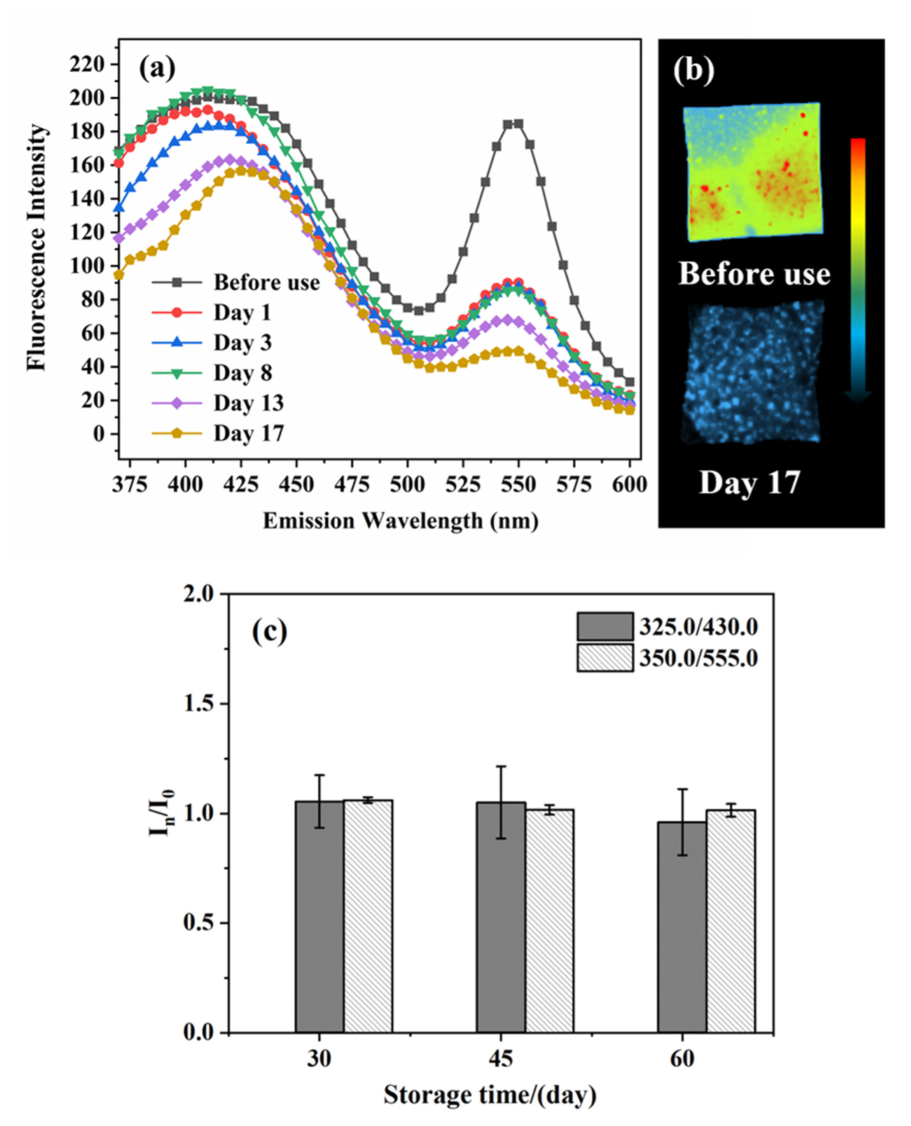
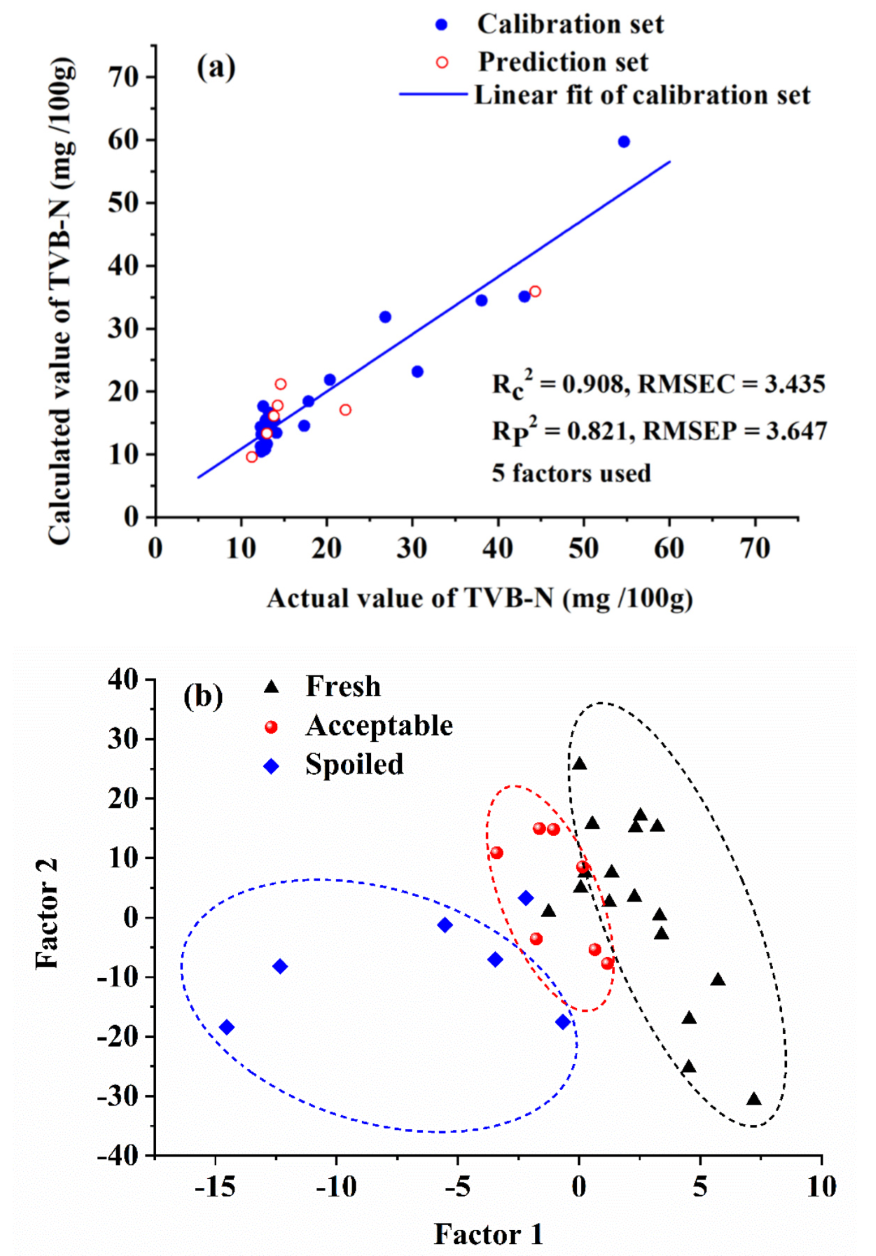
Publisher’s Note: MDPI stays neutral with regard to jurisdictional claims in published maps and institutional affiliations. |
© 2022 by the authors. Licensee MDPI, Basel, Switzerland. This article is an open access article distributed under the terms and conditions of the Creative Commons Attribution (CC BY) license (https://creativecommons.org/licenses/by/4.0/).
Share and Cite
Li, J.; Zhang, N.; Yang, X.; Yang, X.; Wang, Z.; Liu, H. RhB@MOF-5 Composite Film as a Fluorescence Sensor for Detection of Chilled Pork Freshness. Biosensors 2022, 12, 544. https://doi.org/10.3390/bios12070544
Li J, Zhang N, Yang X, Yang X, Wang Z, Liu H. RhB@MOF-5 Composite Film as a Fluorescence Sensor for Detection of Chilled Pork Freshness. Biosensors. 2022; 12(7):544. https://doi.org/10.3390/bios12070544
Chicago/Turabian StyleLi, Jingyi, Ning Zhang, Xin Yang, Xinting Yang, Zengli Wang, and Huan Liu. 2022. "RhB@MOF-5 Composite Film as a Fluorescence Sensor for Detection of Chilled Pork Freshness" Biosensors 12, no. 7: 544. https://doi.org/10.3390/bios12070544
APA StyleLi, J., Zhang, N., Yang, X., Yang, X., Wang, Z., & Liu, H. (2022). RhB@MOF-5 Composite Film as a Fluorescence Sensor for Detection of Chilled Pork Freshness. Biosensors, 12(7), 544. https://doi.org/10.3390/bios12070544



